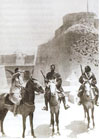Made up of men from the city of Ceuta, the Ceuta garrison’s Permanent Regiment heroically distinguished itself in numerous campaigns in the 18th and 19th centuries, making a name for itself in Italy, French Roussillon, the sieges of Gibraltar and the Carlist Wars. It was here that JACINTO RUIZ MENDOZA—a young cadet born in Ceuta, who joined up on August 17, 1795—was trained and, on May 2, 1808, then a Lieutenant, he became a hero of the Peninsular War along with artillery captains Daoiz and Velarde.
Agustina of Aragon—the heroine of the sieges of Saragossa—, who died in Ceuta on May 29, 1857, was made an honorary member of this Regiment.
One of the most important events of the War of Tetouan (1859-1860) was the Battle of Los Castillejos, where, on January 1, 1860, Spanish forces under the command of General Prim defeated the enemy in an intense eight-hour struggle.
The war ended after the Battle of Wad Ras, on March 23, 1860, and a Peace Treaty was signed two days later. The Treaty stipulated, among other guarantees, the transfer in perpetuity of the territory of Ceuta and its expansion to its current borders.
For reasons of immediate security, the new limits were established at the Bullones Mountains and ratified at the maximum range of a cannon.
In 1860, after the war, construction began on the forts bordering the frontier, which were completed in 1870.
In 1911, the Prison of Ceuta was closed and the last 400 prisoners were transferred to the Peninsula at the beginning of 1912. This had a great impact on the development of the enclave since convicts had previously constituted the majority of the workforce in all the productive sectors and official organizations (crafts, construction, street cleaning, parks, workshops and numerous other services).
In the 20th century, the Spanish-Moroccan Wars (1909-1927) and the establishment of the Spanish Protectorate in Morocco, which lasted until 1956, were the main causes of a significant increase in the civilian population in Ceuta, as well as in the Garrison Units. On July 31, 1914, the 3rd Group of Regular Indigenous Forces of Ceuta was created by Royal Decree, based on the Voluntary Militia of Ceuta.
A few years later, on September 20, 1920, Lieutenant Colonel Millán Astray founded the Spanish equivalent of the Foreign Legion (the Tercio de Extranjeros), which had its first barracks in the so-called “Position A”, a place currently occupied by the García Aldave Barracks.
Ceuta today has become a modern city where Christians, Muslims, Jews and Hindus coexist. Its Statute of Autonomy, approved by Organic Law 1/1995 of March 13, 1995, made it an Autonomous City, and it currently enjoys its own political-administrative system.
During the period from 1918 to 1956, the date of Morocco's Independence, the Commandancy-General of Ceuta was subordinate to the High Commissioner of the Spanish Protectorate in Morocco, both as regards political and military responsibilities.
In 1956, when Morocco gained independence, the Headquarters of the Spanish Army in North Africa was established in Ceuta, and the figures of the Commander-General and his Commandancy became somewhat obsolete since the Chief Lieutenant General of the Army assumed the maximum civil and military authority of the enclave until 1968.
From this date, the Commandancy-General of Ceuta has been integrated into the 2nd Military Region, based in Seville, and, although the Commander-General is subordinate to the Captain-General in military matters, the former has recovered his administrative responsibilities of yesteryear.
In 1978, when he stepped down as Government Delegate, his authority was limited to the military sphere.
On August 1, 1997, a new territorial reorganization provided for the creation of the Military Zone of Ceuta, the Commander-General and Senior General of which reported directly to the Chief of Staff of the Army. A structure of this type had already existed in 1912.
A new restructuring by Royal Decree 416/2006 of April 11, which establishes the organization and deployment of the Army Force, stipulated that the figure of the Commander-General would again report in military matters to the Lieutenant Commander-General of the Land Force, based in Seville.

Motto and emblem of the Commandancy-General of Ceuta
The City of Ceuta was conquered in 1415, during the reign of John I of Portugal, and its first Governor, Pedro de Meneses, established the command baton (El Aleo)—used thereafter by the enclave’s Commander-Generals—and the motto "This stick shall suffice", which appears on the coat of arms of the Commandancy-General.
Since February 20, 1651, the command baton has remained in the Sanctuary of Our Lady of Africa, in the hands of the venerated image of the Virgin, Patron of the City and perpetual Mayoress, to whom the people of Ceuta are especially devoted.
The emblem of the Commandancy-General of Ceuta is inspired by the Portuguese period of Ceuta’s history (1415-1680). It merges the current coat of arms of the Republic of Portugal with the Flag of its Capital, Lisbon, and the tradition of the Commander General’s baton, El Aleo.
It is described as gyronny in sable and argent. A shield argent and five gussets azure in cross with five bezants argent in cross, a border gules with seven crenellated and turreted castles or, masoned sable and ajoure azure. Two in chief, two on each flank and three in base.
The Royal Crown and the upper border represent the Spanish Monarchy, while the red background represents the Army and its infantry.


















